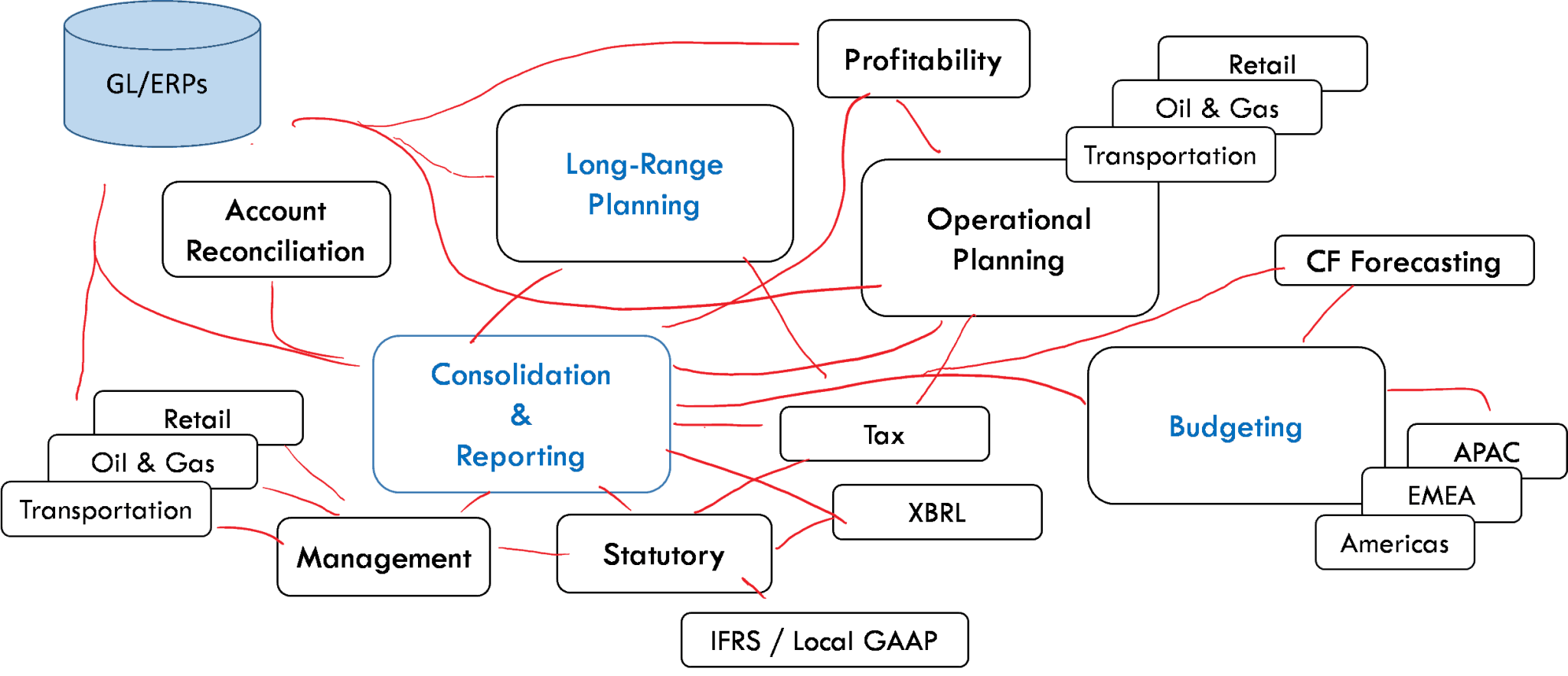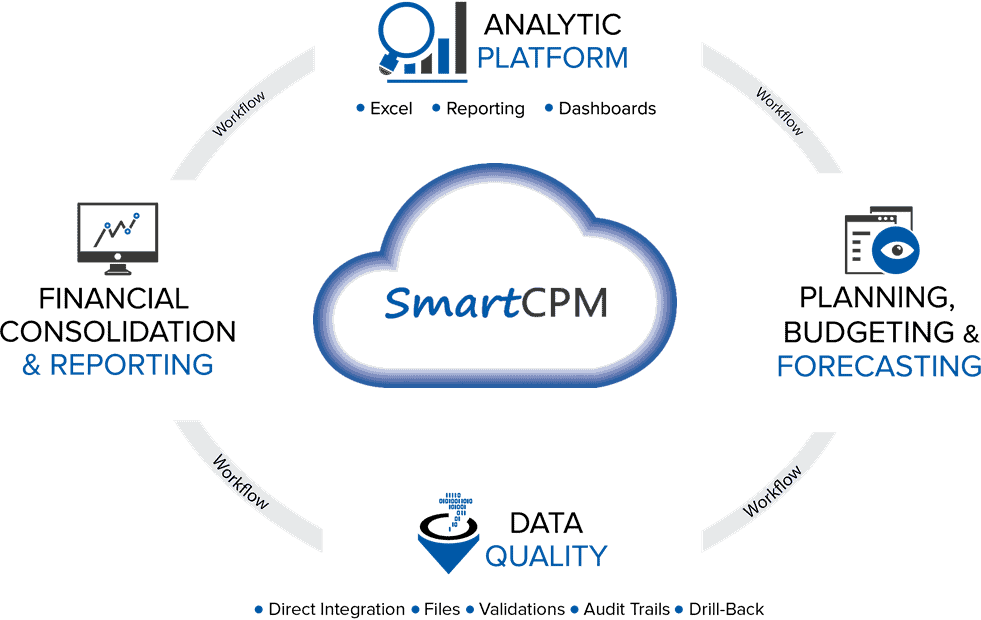Getting your organization to make the move from fragmented, legacy CPM application suites to more modern, unified CPM solutions can be challenging due to many forces. This can include lack of leadership, lack of time, lack of resources, risk avoidance and others. But building a solid and compelling financial business case for a conversion can help get the attention of senior management and spur the entire organization to action.
The Pitfalls of CPM 1.0 Applications
Thousands of organizations around the world are using legacy corporate performance management (CPM 1.0) application suites from mega-vendors such as Oracle/Hyperion, SAP, IBM/Cognos and others. While these products have provided value over spreadsheet and manual approaches, their fragmented architectures cause Finance teams to spend a large amount of their time on data integration and movement between applications, maintaining meta data in multiple systems, and managing upgrades.
The mega-vendor suites typically include separate products or modules for:
Financial Close and Reporting: Data Integration/Data Quality, Financial Consolidation, Financial and Management Reporting, Account Reconciliations, Disclosure Management, Tax Provisioning
Financial Planning and Analysis: Financial Budgeting and Forecasting, Strategic Planning, Workforce Planning, Capital Asset Planning, Project Planning, Sales Planning, Profitability Management, Performance Reporting, Multidimensional Analysis and Modeling
As a result, data from source systems such as GL, HR, CRM and others must be loaded into multiple databases and applications (figure 1). In addition, data must be moved between applications to perform simple tasks such as actual vs. budget or forecast analysis.

Figure 1 – Fragmented CPM 1.0 Applications
The fragmented nature of CPM 1.0 application suites also makes upgrading to new releases a time-consuming and costly effort. So much so, that many organizations put off upgrades for years and then end up on old or unsupported releases of the applications that become unstable and are prone to downtime. And when upgrades are scheduled once every 4-5 years, the underlying hardware infrastructure must also be upgraded. This drives the costs and IT resource requirements even higher, considering the number of servers required to support a suite with 10 or more separate modules.
Oracle and other mega-vendors have begun moving their CPM 1.0 applications to the cloud, which alleviates the headache of setting up and upgrading hardware infrastructure. But the fragmented nature of these application suites still makes them hard to manage and maintain, even in the cloud.
Advantages of CPM 2.0 Solutions
A new generation of CPM solutions has begun appearing on the market, which alleviate many of the headaches associated with CPM 1.0 solutions. CPM 2.0 applications, such as OneStream’s SmartCPMTM platform, are designed to address the same business problems as CPM 1.0, but with a modern architectural approach (figure 2) that addresses the pitfalls of CPM 1.0. Some of the key attributes of CPM 2.0 solutions include:
- A unified application supporting multiple CPM processes
- On-premise or cloud deployment
- Easier and less-costly upgrades (hours vs. weeks/months)
- Integrated analytics that support both corporate and BU requirements
- Easy extensibility to address specific requirements

Figure 2 – Unified CPM 2.0 Application Architecture
CPM 2.0 applications provide many benefits to customers:
- Reduced costs of ownership
- Streamlined reporting and planning processes
- Improved accuracy of financial results, plans and forecasts
Moreover, with CPM 2.0 applications, Finance Transformation is moved forward by enabling teams to shift more time to value-added analysis, partnering with lines of business, and improving alignment and decision-making across the enterprise.
Making the Business Case for Converting to CPM 2.0
While the benefits of converting from CPM 1.0 to CPM 2.0 solutions might seem obvious, in most organizations a business case must be made for investing in the conversion. So what are the key areas of cost-savings that can be quantified to help build this business case?
Here’ a quick guide regarding both hard and soft cost savings that can be identified as you consider moving from a fragmented, multi-product suite to a unified, CPM 2.0 solution:
Areas of potential hard cost savings:
- Savings on software licenses and maintenance/support costs
- Cost savings by avoiding additional add-on module licenses
- Avoidance of costly upgrades of software and infrastructure
- Savings on training and implementation services for additional modules
- IT costs – consolidating servers, OS, databases, other software
- IT staff – savings in applications, infrastructure admins
- Hosting – IT savings by shifting to cloud or hosted offerings
- Eliminating 3rd party software products (e.g. Account Reconciliation software)
- Savings on internal and external audit costs by having a more modern, unified system with better audit trails
These hard cost savings should be considered over the complete life of the solution. The cost savings should also consider production as well as development/test environments for the CPM 1.0 vs. CPM 2.0 solution, which can represent a significant server consolidation opportunity.
In most cases, the business case for converting to a CPM 2.0 solution can be clearly made based on the potential hard cost savings identified above. But by converting from a fragmented CPM 1.0 suite to a unified CPM 2.0 solution, there are process efficiencies that are often realized. These can provide additional soft cost savings which can be included as upside benefit.
Potential Soft Cost Savings:
- Less Finance staff time on data integration, validation
- Less Finance staff time on consolidation and reporting
- Less Finance staff time on budgeting, forecasting
- Less Finance staff time on management reporting, board books, presentations
These productivity savings often enable Finance departments to deploy their staff members on higher value analysis activities, and/or helps avoid the need to add additional headcount over time. And there’s another upside benefit that’s often difficult to quantify. That is that faster delivery of information to management leads to faster decision-making on cost avoidance, leveraging new market opportunities, and improving product/customer profitability
In our experience, taking this approach to identifying both the hard and soft cost savings by converting from fragmented CPM 1.0 applications to unified CPM 2.0 solutions has led many organizations to realize millions of dollars in savings, 50% or higher returns on investment, and payback as fast as 2 years.
Business Case Example
Here’s an example of a hypothetical customer business case comparing the acquisition and ongoing support for a typical set of legacy CPM applications (e.g. Oracle Hyperion) for financial close & consolidation, reporting and planning vs. OneStream’s unified SmartCPM platform.
For a deployment of 100 users, plus 2 administrators over 5 years, the unified CPM 2.0 application provides a savings of 47% compared to the legacy CPM Suite, for a total savings of $2.5M over 5 years. This includes the following:
- Savings on software licenses and maintenance $872,000
- Savings on hardware $113,000
- Savings on implementation $648,000
- Savings on ongoing IT support $950,000
What the Experts are Saying
In a recent BPM Partners white paper titled “Lower TCO with Unified BPM Applications”, here’s what author Craig Schiff had to say about the benefits of converting from CPM 1.0 to CPM 2.0 solutions:
“Going module-by-module, mixing and cross-integrating products proved to be lucrative for software vendors and consultants, but it was expensive for users, with inevitable headaches in implementation and maintenance. Users report five-and six-digit savings on unified applications in: licensing fees, support contracts, integration work, infrastructure and hardware, and salaries.
Their time savings, with a unified application versus module-by-module solution, are realized in less work of tracking licenses, getting modules to work together, making a change across multiple applications, upgrades, and chasing after support on multiple process-focused solutions.
For unified applications that are built for extendibility to new processes—such as operational activities outside Finance—there are additional cost and time savings. For organizations that need to contain costs in their BPM efforts, we recommend considering unified applications in your selection process. We further suggest that you look closely at the functionality in whichever process is most critical to you—usually budgeting or consolidation—and at the ease of extending the solution to your company’s other processes and solutions in the future.”
To learn more about the benefits of converting from CPM 1.0 applications to CPM 2.0 solutions, download the BPM Partners white paper. You can also click here to review customer case studies and videos. And contact OneStream if you would like a free Hyperion conversion assessment.
John O’Rourke is Vice President of Product Marketing at OneStream Software. With a background in accounting and finance, John has over 30 years of experience in the software industry, including 20 years of experience in product marketing at Hyperion Solutions, Oracle and Host Analytics. He has worked with many customers and partners on financial reporting and planning initiatives and has spoken and written on many topics in corporate performance management. John has also held positions in strategic marketing and product marketing at Dun & Bradstreet Software, Kenan Systems and Decisyon.
Don’t Miss Another Blog Article, Subscribe Today!
Get Started With a Personal Demo


